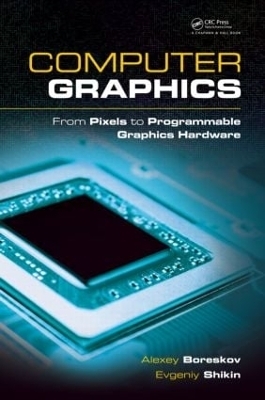
Computer Graphics
From Pixels to Programmable Graphics Hardware
Seiten
2013
Chapman & Hall/CRC (Verlag)
978-1-4398-6730-3 (ISBN)
Chapman & Hall/CRC (Verlag)
978-1-4398-6730-3 (ISBN)
- Titel z.Zt. nicht lieferbar
- Versandkostenfrei
- Auch auf Rechnung
- Artikel merken
Complete Coverage of the Current Practice of Computer GraphicsComputer Graphics: From Pixels to Programmable Graphics Hardware explores all major areas of modern computer graphics, starting from basic mathematics and algorithms and concluding with OpenGL and real-time graphics. It gives students a firm foundation in today’s high-performance graphics.
Up-to-Date Techniques, Algorithms, and APIThe book includes mathematical background on vectors and matrices as well as quaternions, splines, curves, and surfaces. It presents geometrical algorithms in 2D and 3D for spatial data structures using large data sets. Although the book is mainly based on OpenGL 3.3, it also covers tessellation in OpenGL 4.0, contains an overview of OpenGL ES 2.0, and discusses the new WebGL, which allows students to use OpenGL with shaders directly in their browser. In addition, the authors describe a variety of special effects, including procedural modeling and texturing, fractals, and non-photorealistic rendering. They also explain the fundamentals of the dominant language (OpenCL) and platform (CUDA) of GPGPUs.
Web ResourceOn the book’s CRC Press web page, students can download many ready-to-use examples of C++ code demonstrating various effects. C++ wrappers for basic OpenGL entities, such as textures and programs, are also provided.
In-Depth Guidance on a Programmable Graphics PipelineRequiring only basic knowledge of analytic geometry, linear algebra, and C++, this text guides students through the OpenGL pipeline. Using one consistent example, it leads them step by step from simple rendering to animation to lighting and bumpmapping.
Key Features
Covers the main aspects of modern computer graphics
Explains how to create various special effects using OpenGL
Describes a wide range of current topics, such as tessellation, spherical harmonics, and geometric shaders
Contains practical exercises and examples as well as numerous illustrations, including several color images
Offers full, cross-platform source code and examples on the book’s CRC Press web page
Figure slides available upon qualifying course adoption
Up-to-Date Techniques, Algorithms, and APIThe book includes mathematical background on vectors and matrices as well as quaternions, splines, curves, and surfaces. It presents geometrical algorithms in 2D and 3D for spatial data structures using large data sets. Although the book is mainly based on OpenGL 3.3, it also covers tessellation in OpenGL 4.0, contains an overview of OpenGL ES 2.0, and discusses the new WebGL, which allows students to use OpenGL with shaders directly in their browser. In addition, the authors describe a variety of special effects, including procedural modeling and texturing, fractals, and non-photorealistic rendering. They also explain the fundamentals of the dominant language (OpenCL) and platform (CUDA) of GPGPUs.
Web ResourceOn the book’s CRC Press web page, students can download many ready-to-use examples of C++ code demonstrating various effects. C++ wrappers for basic OpenGL entities, such as textures and programs, are also provided.
In-Depth Guidance on a Programmable Graphics PipelineRequiring only basic knowledge of analytic geometry, linear algebra, and C++, this text guides students through the OpenGL pipeline. Using one consistent example, it leads them step by step from simple rendering to animation to lighting and bumpmapping.
Key Features
Covers the main aspects of modern computer graphics
Explains how to create various special effects using OpenGL
Describes a wide range of current topics, such as tessellation, spherical harmonics, and geometric shaders
Contains practical exercises and examples as well as numerous illustrations, including several color images
Offers full, cross-platform source code and examples on the book’s CRC Press web page
Figure slides available upon qualifying course adoption
Alexey Boreskov (Moscow State University, Russia) (Author) , Evgeniy Shikin (Moscow State University, Russia) (Author)
Introduction: Basic Concepts. Transforms in 2D. Geometric Algorithms in 2D. Transformations in 3D, Projections, Quaternions. Basic Raster Algorithms. Color and Color Models. Basic freeglut and GLEW for OpenGL Rendering. Hidden Surface Removal. Modern OpenGL: The Beginning. Working with Large 2D/3D Data Sets. Curves and Surfaces: Geometric Modeling. Basics of Animation. Lighting Models. Advanced OpenGL. GPU Image Processing. Special Effects in OpenGL. Basics of GPGPU. Elements of Procedural Texturing and Modeling. Non-Photorealistic Rendering. Bibliography.
| Erscheint lt. Verlag | 15.11.2013 |
|---|---|
| Reihe/Serie | Chapman & Hall/CRC Computer Graphics, Geometric Modeling, and Animation Series |
| Zusatzinfo | 10 Tables, black and white; 322 Illustrations, black and white |
| Sprache | englisch |
| Maße | 156 x 234 mm |
| Gewicht | 1230 g |
| Themenwelt | Kunst / Musik / Theater |
| Informatik ► Grafik / Design ► Film- / Video-Bearbeitung | |
| Informatik ► Software Entwicklung ► Spieleprogrammierung | |
| Mathematik / Informatik ► Informatik ► Theorie / Studium | |
| ISBN-10 | 1-4398-6730-5 / 1439867305 |
| ISBN-13 | 978-1-4398-6730-3 / 9781439867303 |
| Zustand | Neuware |
| Haben Sie eine Frage zum Produkt? |
Mehr entdecken
aus dem Bereich
aus dem Bereich
Schritt für Schritt zum perfekten Film: Videoschnitt, Effekte, Sound
Buch | Hardcover (2021)
Rheinwerk (Verlag)
CHF 69,85


